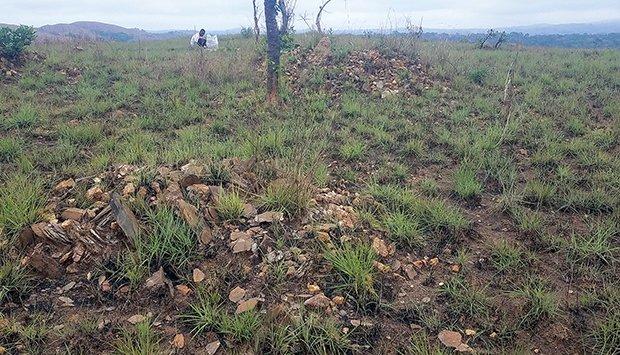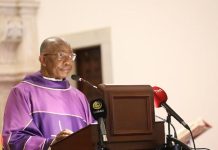Africa-Press – Angola. In several places in the corridor that runs between Lukala, in Cuanza Norte, and Vista Alegre, in Uíge, piles of exposed stones can be seen on mountain slopes or in small elevations, which residents of these localities told Jornal de Angola were of “Mbila za Mbundu”, the same as “Cemeteries of the Ambundu” in the literal translation, whose existence dates back several centuries.
Groups ranging from five to more than ten of these graves can usually be found, never exceeding a little more than twenty. In the surroundings or between the tombs, trees grew today visibly aged.
Abilio Panzu, around 90 years old, said that as a child these tombs already existed. “The elders said they did not know the authors of the aforementioned graves, which they called Mbila za Ambundu”, he said, adding that he had heard stories that pointed to the existence of animals that desecrated the corpses buried in shallow graves.
Even in his teenage years, according to the elder, he never saw such animals, which presumably became extinct with time as they did not adapt to the changes in the environment. The possibility of the existence of animals that desecrated the corpses is shared by the Capita (the highest authority among the three chiefs of the village of Kaboko, where several of these cemeteries are seen). Domingos Macotilo recalls that his grandparents said that such animals “were very large and violent”.
Asked if his grandparents got to know these animals, Domingo Macotilo said that they would have heard the stories of his parents. “Neither did they live that time either. They also heard from their ancestors.”
The press found these concentrations of graves precisely in mountains, hills and mountain ranges in the localities of Mataba and Coio, in Lukala, Kakulo Kabaça, Mbondo Kaluaxi and in Banga, in Kwanza Norte, between the east and west banks of the river Nzenza. Others can be found in the ancient region of Pangu, which the settlers called Aldeia Nova, still in Kwanza Norte, when they most likely settled here in the early 19th century, in the villages of Kapichongo, Mbala Kibuba, Mbanza ya Mbanze and others arranged in a mountain range along the Lufua River, which flows into the Ndanji River. In Mbanza Kabolo such Mbila za Mbundu are scattered and in large concentrations, a scenario that continues to be seen throughout the route that will reach Vista Alegre, in the municipality of Kitexi. Jornal de Angola did not find any of these cemeteries in forests, they are all exposed in places with only low grass.
It can be seen that most of these concentrations are in places close to large rivers or permanent watercourses and in lands suitable for agricultural activity as well as hunting, which can presuppose that these Ambundu would have established population concentrations there. The populations that currently reside in these territories are dedicated to river fishing, hunting and farming.
The press found that the territory of Lukala is inhabited by Kimbundu speakers; these are also in Banga, on the western part of the Nzenza River, in Mbondo Kaluaxi and in Kakulu Kabaça. The Hungu are in the northern corridor of the Lumbinji River, that is, in the territories that used to be called Pangu, up to Mufuki, which is also inhabited by the Ngola.
Oral tradition versus history
In an interview he gave, King Ndembu to Mufuki, in Kambaamba, Vista Alegre, municipality from Ndanji to Kitexi, in Uíge province, stated that his people belonged to the Ngola.
The region from Ndembo to Mufuki would have been the final destination of some Ngola peoples expelled from Luanda by Portuguese settlers, around the 16th century, being also the meeting point of other peoples who, for the same reasons, arrived in this region.
The local authority believed that they were their ancestors who fled from Luanda Island, passed through Mulemba Xangola, went to present-day Kifangondo, from where they ascended with the Nzenza River (Zenza or Bengo) and settled in the Pungu-a region. – Ndongo, always under the command of King Ngola Kiluangi Kia Samba, Ndambi being Ngola and Mbandy Ngola his two faithful coadjutors.
The now Dembo Dom Henrique Manuel, current ruler of Mufuki, accompanied by his collaborators and advisers, said that when they arrived in Malanje and King Ngola Kiluanji Kia Samba dies, Mbandy Ngola took the reins of the leadership of the people and believing that there were no conditions for security, faced with the colonial onslaught and the impossibility of continuing the flight, they had to retreat, crossing again several regions of the current provinces of Cuanza Norte and Bengo, where some of the caravan members stayed, forming villages there, such as Kilombo dos Ndembu , the region of the Ndembu (Dembos), Kakulu ka Ngola, Mbula a Tumba, Pangu and other surroundings today inhabited by Kimbundu and Hungu populations.
“They no longer returned with the same line as Catete, where they had gone up. They came from this line from Ndalatando, crossed the Nzenza and descended with the Lumbingi River”, said the sovereign.
The others, always at the orders and command of King Mbandy to Ngola, continued until they reached the areas of Nambuangongo and settled in Mukondo. “Not a year has passed, the king himself, Mbandy a Ngola, dies”.
However, the professor of History at the Instituto Superior de Ciências da Educação, Nicodemos Paulo Bunga, refutes the presence of these figures in that region and time.
“Ngola Kiluangi, MBandy a Ngola or Mbandy a Ngola have never been in this region”. For him, many sovereigns of the most recent times took the names of the most ancient high entities of the kingdom, hence the oral sources link certain events to these high places older historical entities.
For More News And Analysis About Angola Follow Africa-Press






